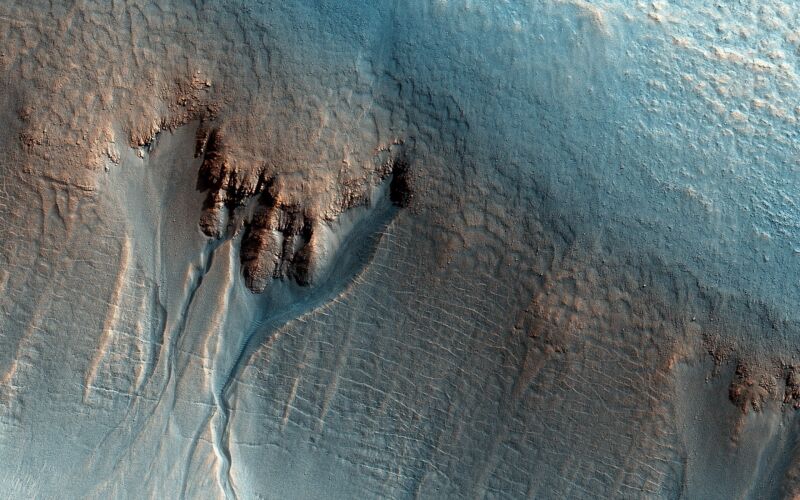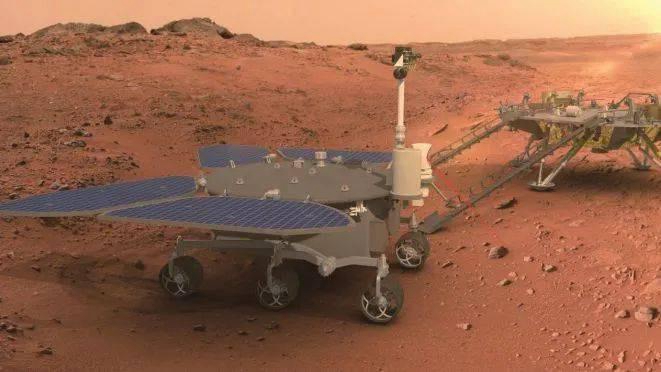
Most of Mars appears to be an endless expanse of alien desert, without a river or lake in sight. However, liquid water definitely existed in the planet’s distant past. A new paper has also suggested that it's also possible small quantities of water still might exist in places that otherwise appear barren.
Before China’s Zhurong (also known as Phoenix) rover went into hibernation mode last May, researchers from the National Astronomical Observatories and the Institute of Atmospheric Physics of the Chinese Academy of Sciences discovered something unexpected. Zhurong was exploring the Utopia Planitia region, which is near the planet’s equator. No liquid water was thought to exist at those latitudes. Yet when the rover beamed back data from its Multispectral Camera (MSCam), Navigation and Terrain Camera (NaTeCam), and Mars Surface Composition Detector (MarSCoDe), there was possible evidence for liquid water having been present less than half a million years ago.
“[Our findings] suggest [features] associated with the activity of saline water, indicating the existence of water process on the low-latitude region of Mars,” the researchers said in a study recently published in Science Advances.
Dry with a soggy past
Zhurong is part of China’s Tianwen-1 Mars mission, which has helped expand our understanding of the environment on Mars. But evidence suggesting there was recently (at least in geological terms) liquid water is unexpected. Because Mars has lost most of its atmosphere and is exposed to intense radiation and solar wind, it was previously thought that water could not exist as a liquid there. Any that did form should quickly freeze or evaporate due to the extremely low pressure and a lack of water vapor.
It is especially dry at the lower latitudes where there are no glaciers, but Zhurong found features on dune surfaces that made the researchers, led by geologist Xiaoguang Qin, suspicious. These include cracks and crusts that must have been left behind when liquid water evaporated from the reddish soil. Further investigation revealed that the surfaces of these dunes were hiding hydrated silica and sulfates, minerals that contain water molecules, along with certain iron oxides and what seem to be chlorides.
Both the presence of these substances and the surface features observed by Zhurong most likely indicate that frost or snow had once fallen, melted, and seeped into the upper layer of the soil. It formed a brine after interacting with salt in the dunes, and formed something of a cement when combined with grains of sand. These cements become crusts after they evaporate.
How'd that get here?
But if there really was water at the lower latitudes no more than 1.4 million and as little as 400,000 years ago, how did it get there?
Mars has gone through different epochs just like Earth. Its Amazonian period began some 2.9 billion years ago and extends to the present. After the transition from the Hesperian to the Amazonian period, Mars was no longer barraged by asteroids, while volcanic activity (some of which was triggered by those collisions) dropped considerably. Although most of its atmosphere had vanished by then, and the climate was drying out, there were still warm and humid periods.
Qin and his team think it was during these periods that water vapor from the frozen poles would spread to the warmer equator. This vapor would solidify into snow or frost during cooler weather and fall to the ground. It would then melt and evaporate when temperatures rose, leaving salty crusts behind.
This discovery could have implications for past or present habitability on Mars. As the climate evolved, so did the planet’s potential for hosting life (though whether it ever did remains a mystery). Future rovers may search for signs of life in areas that were overlooked before, especially where there are crusts, cracks, and depressions that might be telltale signs of water once having been present.
“As saline water once existed at various latitudes on the surface of Mars,” the researchers said, “priority should be given to salt-tolerant microbes in future missions searching for extant life on Mars.”
Science Advances, 2023. DOI: 10.1126/sciadv.add886 (About DOIs).
Elizabeth Rayne is a creature who writes. Her work has appeared on SYFY WIRE, Space.com, Live Science, Grunge, Den of Geek, and Forbidden Futures. When not writing, she is either shapeshifting, drawing, or cosplaying as a character nobody ever heard of. Follow her on Twitter @quothravenrayne.



3175x175(CURRENT).thumb.jpg.b05acc060982b36f5891ba728e6d953c.jpg)

Recommended Comments
There are no comments to display.
Join the conversation
You can post now and register later. If you have an account, sign in now to post with your account.
Note: Your post will require moderator approval before it will be visible.